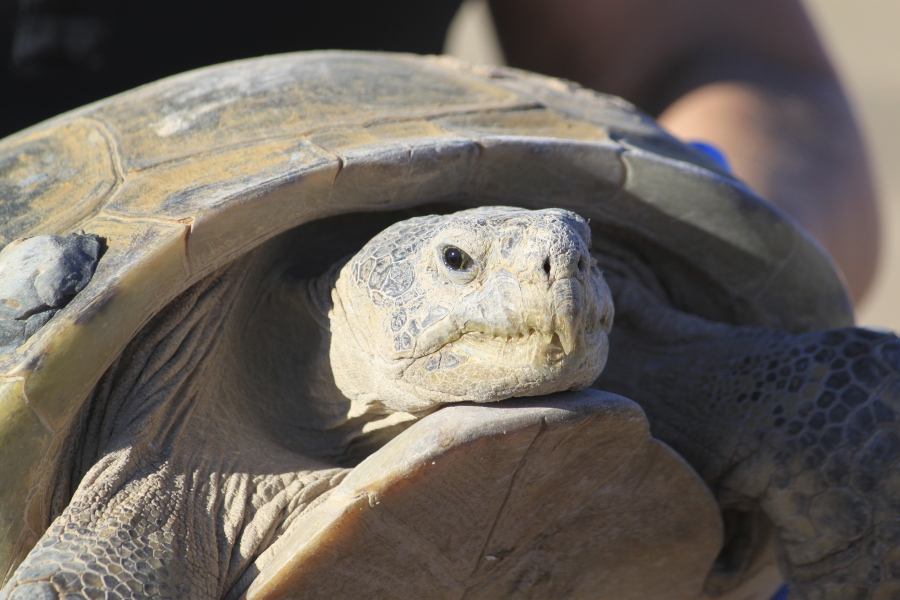ENGLE, N.M. — While the average lifespan of North America’s largest and most rare tortoise species is unknown, biologists have said it could span upward of a century.
So saving the endangered species is a long game — one that got another nudge forward Friday as U.S. wildlife officials finalized an agreement with Ted Turner’s Endangered Species Fund that clears the way for the release of more Bolson tortoises on the media mogul’s ranch in central New Mexico.
The “safe harbor agreement” will facilitate the release of captive tortoises on the Armendaris Ranch to establish a free-ranging population. U.S. Fish and Wildlife Service Director Martha Williams said the agreement, which offers private landowners protections from regulations, can serve as a model as officials look for more innovative ways to work within the Endangered Species Act.
Dozens of people gathered for the release Friday of 20 more adult tortoises on the property, which is already home to 23 of them as well as dozens of juvenile ones. With the sun high in the sky and temperatures nearing 90 degrees, the release was held off until the evening to ensure their well-being.
The tortoises usually spend about 85 percent of the time in their earthen burrows, which in some cases can be about 21 yards long.
Shawn Sartorius, a field supervisor with the Fish and Wildlife Service, said the results of the breeding and restoration efforts for the slow-reproducing and long-lived animals will not be known in his lifetime.
“What we’re doing here is establishing a population here that can be handed off to the next generation,” Sartorius said.
It’s a step toward one day releasing the tortoise more broadly in the Southwest as conservationists push the federal government to consider crafting a recovery plan for the species. The tortoise is just the latest example of a growing effort to find new homes for endangered species as climate change and other threats push them from their historic habitats.
Now found only in the grasslands of north-central Mexico, the tortoise once had a much larger range that included the southwestern United States. Fossil records also show it was once present it the southern Great Plains, including parts of Texas and Oklahoma.
The wild population in Mexico is thought to consist of fewer than 2,500 tortoises, and experts say threats to the animals are mounting as they are hunted for food and collected as pets. Their habitat also is shrinking as more desert grasslands are converted to farmland.
While it’s been eons since the tortoises roamed wild in what is now New Mexico, Mike Phillips, director of the Turner Endangered Species Fund, said it’s time for biologists to reconsider what ecological reference points should matter most when talking about the recovery of an imperiled species.
Climate change is reshuffling the ecological deck and changing the importance of historical conditions in the recovery equation, Phillips said. He pointed to the case of the tortoise, noting that suitable habitat is moving north again as conditions in the Southwestern U.S. become drier and warmer.
Absent a willingness by wildlife managers to think more broadly, he said, species like the Bolson tortoise could have a bleak future.
“It would seem in a recovery context, historical range should be considered. Prehistoric range sometimes matters too,” he said in an interview. “But most importantly, future range — because recovery is all about righting a wrong, it’s about improving conditions. The future is what is of great relevance to recovery.”
Sartorius, of the U.S. Fish and Wildlife Service, agreed, saying managers can’t look narrowly at historic range and still keep animals like the tortoise on the planet.
The question that biologists have been trying to answer is whether the Armendaris Ranch makes for a good home.
So far the ranch, spanning more than 560 square miles is proving to be an ideal spot. The landscape is similar to that where the tortoises are found in Mexico, and work done on the ranch and at the Living Desert Zoo and Gardens in Carlsbad has resulted in more than 400 tortoises being hatched since 2006.
In all, the Turner Endangered Species Fund and its partners have been able to grow the population from 30 tortoises to about 800, said Chris Wiese, who leads the project at the Armendaris Ranch.



